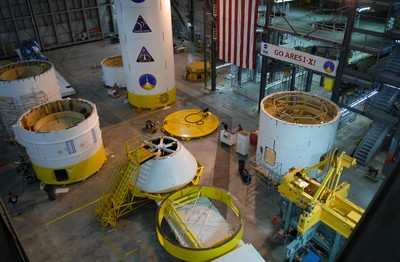Tue, Jun 30, 2009
Vibrations During Launch Might Cause Severe Problems, USAF
Says
 Air Force Officials, who are charged with safety during
launch operations at Kennedy Space Center, are concerned that
harmonic vibrations from the cluster of solid rocket boosters used
on the Ares I-X could knock out both the launch vehicle's Thrust
Vector Control and self destruct mechanism. The result, officials
say, could be extremely dangerous for people living along Florida's
east coast.
Air Force Officials, who are charged with safety during
launch operations at Kennedy Space Center, are concerned that
harmonic vibrations from the cluster of solid rocket boosters used
on the Ares I-X could knock out both the launch vehicle's Thrust
Vector Control and self destruct mechanism. The result, officials
say, could be extremely dangerous for people living along Florida's
east coast.
The concerns may delay or even cancel the planned August 30th
test launch, according to an exclusive report in The Orlando
Sentinel.
While the solid rocket boosters are proven technology, Jon
Cowart, NASA's deputy Ares I-X program manager, told the paper
that "if you change little things, it's amazing the amount of
reanalysis you have to go do. You're not starting from scratch. But
you're not as far down the road as you probably thought you
were."
The Ares-I will eventually carry astronauts back to the moon,
but those missions aren't planned for more than a decade.
Engineers used the same self-destruct mechanism on the Ares I-X
as are used on the shuttle, but the vibrations during launch are
apparently much more severe. According to internal NASA documents
obtained by the paper, the vibrations with enough force to knock
out the self-destruct mechanism could come 60-90 seconds into the
flight, with a TVC failure coming as much as 2 minutes into the
flight. The Air Force requires an assurance that the self-destruct
system will work properly, 99.9 percent, according to Lt. Col.
Loretta Kelemen, head of the Cape Canaveral Air Force Station 45th
Space Wing Range Safety Office. "If they do not meet our
requirements, then they do not launch here."

Cower told the paper he doesn't think the vibrations, which are
called "sympathetic" among the SRB's and could cause the vehicle to
act like a tuning fork, will ever be severe enough to effect either
the Thrust Vector Control or the Flight Termination System. "We've
done our analysis one way. They do it another way."
More News
Aero Linx: JAARS Nearly 1.5 billion people, using more than 5,500 languages, do not have a full Bible in their first language. Many of these people live in the most remote parts of>[...]
'Airplane Bounced Twice On The Grass Runway, Resulting In The Nose Wheel Separating From The Airplane...' Analysis: The pilot reported, “upon touchdown, the plane jumped back>[...]
"Burt is best known to the public for his historic designs of SpaceShipOne, Voyager, and GlobalFlyer, but for EAA members and aviation aficionados, his unique concepts began more t>[...]
"Polaris Dawn, the first of the program’s three human spaceflight missions, is targeted to launch to orbit no earlier than summer 2024. During the five-day mission, the crew >[...]
There Are SO Many Ways To Get YOUR Aero-News! It’s been a while since we have reminded everyone about all the ways we offer your daily dose of aviation news on-the-go...so he>[...]
 ANN's Daily Aero-Linx (05.04.24)
ANN's Daily Aero-Linx (05.04.24) NTSB Final Report: Quest Aircraft Co Inc Kodiak 100
NTSB Final Report: Quest Aircraft Co Inc Kodiak 100 Aero-News: Quote of the Day (05.04.24)
Aero-News: Quote of the Day (05.04.24) Aero-News: Quote of the Day (05.05.24)
Aero-News: Quote of the Day (05.05.24) Read/Watch/Listen... ANN Does It All
Read/Watch/Listen... ANN Does It All




